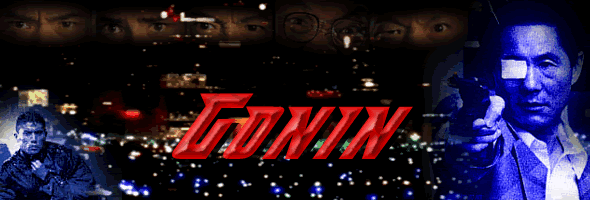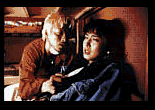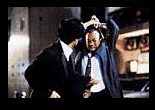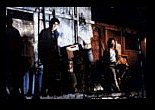
Color, 1995, 108 mins. Written and Directed by Takashi Ishii
Starring Koichi Sato, Masahiro Motoki, Kitano "Beat" Takeshi, Naoto Takenaka, Jinpachi Nezu, Kippei Shiina, Toshiyuki Nagashima, Kazuya Kimuna / Music by Goro Yasukawa / Cinematography by Yasushi Sakakibara
Format: DVD - Ocean Shores (approx. $25)
Letterboxed (1.85:1) / Dolby Digital 4.0
A young disco owner, Bandai (Koichi Sato), suffers from surrealistic nightmares as he tries to cope with his debts to the Yakuza. Mitsuya (Masahiro Motoki), a young gender bender fresh out of jail, makes a living blackmailing rich gay men and thinks Bandai was involved in his conviction. The two men sort things out, however, and cook up a foolproof scheme to come up with some fast cash: rob the mob! Unlike many gangster/heist films, which operate on a purely superficial level with plenty of gloss to distract unsuspecting viewers, Gonin has quite a few agendas tucked under its beautifully designed sleeves. The vicious social commentary attacks depersonalized corporations which allow crime to fester and grow while individuals wind up torn to shreds in the process, and the startling homoeroticism which crops up throughout the film comes as a slap in the face to the usual buddy/buddy action formula. The two hitmen, featuring legendary director and Jolt spokesman "Beat" Takeshi (Sonatine, Hana-bi), happen to be an incredibly dysfunctional gay couple and provide the film's most shocking, memorable scene, but the other characters also contain submerged traits indicating that sexuality, just like morality, isn't simply a matter of black or white. The opening half hour may seem jagged and difficult to follow on first viewing, but it skillfully sets up the atmosphere of disorientation which ultimately swerves from standard fare to full blooded visceral horror in the final hour. Released briefly to U.S. specialty houses by Phaedra in 1998, Gonin has inexplicably remained unavailable to American home viewers outside of The Sundance Channel's handful of graveyard shift screenings. The long overdue DVD from Ocean Shores is surprisingly good, taken from an exceptionally clean and vibrant print. Like another homoerotic mob heist film by former comic artists, Bound, this film is drenched in darkness virtually from start to finish, with only a few brief (but highly effective) moments set in broad daylight. The dream opening and club scenes in particular are very murky looking, as originally intended, but look clear, well-defined, and similar to the theatrical appearance. Colors are vivid, solid, and appealing, often drenched in bright neon and stylish Argentoesque bursts of primary hues. The American version looks essentially the same, except the Ocean Shores DVD (thankfully only emblazoned twice during the film with their usual onscreen logo) adds Chinese subtitles above the same English ones.
As stylish and disturbing a crime film as the '90s is likely to produce, the Japanese production Gonin (The Five) fuses the darkest popular arthouse trends into one eye-catching, brutal package guaranteed to linger in viewers' memories long after the film is over. Director Takashi Ishii (Black Angel), an established manga artist, depicts Japan -- and indeed, civilization as a whole, perhaps -- as a rapidly degenerating social structure where outcasts and corruptors feed on each other, with tragic results.
 Hizu (Jinpachi Nezu), a former cop disgraced in the public eye for his gambling problems, joins the fold, as does a bleach-blond pimp, Jimmy (Kippei Shiina). Their plotting is overheard by a jittery businessman, Ogiwara (Naoto Takenaka, that dancing fool from Shall We Dance?), who has been recently shattered by his corporation's downsizing, and he manages to weasel his way in, too. Together, the five men manage to pull off the robbery, but the mob kingpin, Ogoshi (Toshiyuki Nagashima), immediately hires two hitmen to track down the five thieves and dispatch them... at any cost.
Hizu (Jinpachi Nezu), a former cop disgraced in the public eye for his gambling problems, joins the fold, as does a bleach-blond pimp, Jimmy (Kippei Shiina). Their plotting is overheard by a jittery businessman, Ogiwara (Naoto Takenaka, that dancing fool from Shall We Dance?), who has been recently shattered by his corporation's downsizing, and he manages to weasel his way in, too. Together, the five men manage to pull off the robbery, but the mob kingpin, Ogoshi (Toshiyuki Nagashima), immediately hires two hitmen to track down the five thieves and dispatch them... at any cost.
 Thoroughly unpredictable, Gonin tosses in a number of creepy surprises to add some flavor to the usual gun battles, leading to a chilling final scene that would have made Edgar Allan Poe proud.
Thoroughly unpredictable, Gonin tosses in a number of creepy surprises to add some flavor to the usual gun battles, leading to a chilling final scene that would have made Edgar Allan Poe proud.
 Though not entirely comprehensive and occasionally difficult to read against white backgrounds, the burned-in English subtitles are large and easily get the point across. The major difference between the two versions, however, lies in the soundtrack. While the Phaedra print featured a dull, one-dimensional sound mix, the DVD boasts a spacious and effective, full-bodied surround mix. The imaginative score, which uses castanets as musical harbingers of death a la The Leopard Man, sounds fantastic and often looms up from the rear speakers, though sound effects outside of the usual directional gunfire are essentially limited to the center and occasionally front speakers. Due to the proliferation of extra company logos in America, the U.S. cut actually runs almost a minute longer, but the prints are identical in terms of the film's content. Shot hard-matted at 1.85:1, the framing looks perfect and appears to expose the entire available image. Simply put, this region free DVD, which also includes the fantastic original Japanese trailer, is a very welcome, essential release; while mainstream viewers bred on Quentin Tarantino may be shocked by the ruthlessness on display here, adventurous filmgoers willing to explore a fusion of hard-hitting action and aesthetic horror should absolutely take the trouble to seek this one out.
Though not entirely comprehensive and occasionally difficult to read against white backgrounds, the burned-in English subtitles are large and easily get the point across. The major difference between the two versions, however, lies in the soundtrack. While the Phaedra print featured a dull, one-dimensional sound mix, the DVD boasts a spacious and effective, full-bodied surround mix. The imaginative score, which uses castanets as musical harbingers of death a la The Leopard Man, sounds fantastic and often looms up from the rear speakers, though sound effects outside of the usual directional gunfire are essentially limited to the center and occasionally front speakers. Due to the proliferation of extra company logos in America, the U.S. cut actually runs almost a minute longer, but the prints are identical in terms of the film's content. Shot hard-matted at 1.85:1, the framing looks perfect and appears to expose the entire available image. Simply put, this region free DVD, which also includes the fantastic original Japanese trailer, is a very welcome, essential release; while mainstream viewers bred on Quentin Tarantino may be shocked by the ruthlessness on display here, adventurous filmgoers willing to explore a fusion of hard-hitting action and aesthetic horror should absolutely take the trouble to seek this one out.
